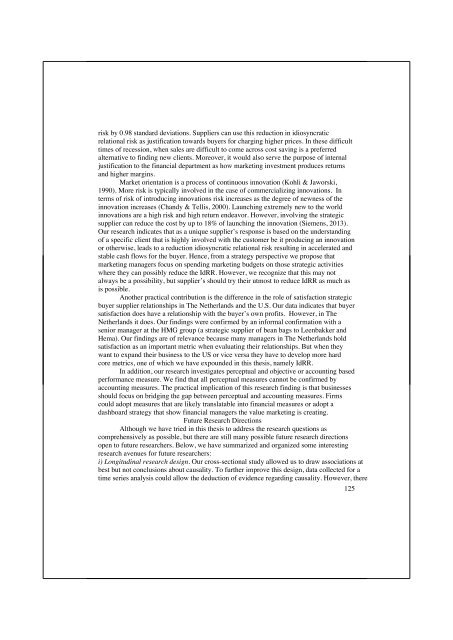Essays on supplier responsiveness and buyer firm value - Nyenrode ...
Essays on supplier responsiveness and buyer firm value - Nyenrode ...
Essays on supplier responsiveness and buyer firm value - Nyenrode ...
Create successful ePaper yourself
Turn your PDF publications into a flip-book with our unique Google optimized e-Paper software.
isk by 0.98 st<strong>and</strong>ard deviati<strong>on</strong>s. Suppliers can use this reducti<strong>on</strong> in idiosyncratic<br />
relati<strong>on</strong>al risk as justificati<strong>on</strong> towards <strong>buyer</strong>s for charging higher prices. In these difficult<br />
times of recessi<strong>on</strong>, when sales are difficult to come across cost saving is a preferred<br />
alternative to finding new clients. Moreover, it would also serve the purpose of internal<br />
justificati<strong>on</strong> to the financial department as how marketing investment produces returns<br />
<strong>and</strong> higher margins.<br />
Market orientati<strong>on</strong> is a process of c<strong>on</strong>tinuous innovati<strong>on</strong> (Kohli & Jaworski,<br />
1990). More risk is typically involved in the case of commercializing innovati<strong>on</strong>s. In<br />
terms of risk of introducing innovati<strong>on</strong>s risk increases as the degree of newness of the<br />
innovati<strong>on</strong> increases (Ch<strong>and</strong>y & Tellis, 2000). Launching extremely new to the world<br />
innovati<strong>on</strong>s are a high risk <strong>and</strong> high return endeavor. However, involving the strategic<br />
<strong>supplier</strong> can reduce the cost by up to 18% of launching the innovati<strong>on</strong> (Siemens, 2013).<br />
Our research indicates that as a unique <strong>supplier</strong>’s resp<strong>on</strong>se is based <strong>on</strong> the underst<strong>and</strong>ing<br />
of a specific client that is highly involved with the customer be it producing an innovati<strong>on</strong><br />
or otherwise, leads to a reducti<strong>on</strong> idiosyncratic relati<strong>on</strong>al risk resulting in accelerated <strong>and</strong><br />
stable cash flows for the <strong>buyer</strong>. Hence, from a strategy perspective we propose that<br />
marketing managers focus <strong>on</strong> spending marketing budgets <strong>on</strong> those strategic activities<br />
where they can possibly reduce the IdRR. However, we recognize that this may not<br />
always be a possibility, but <strong>supplier</strong>’s should try their utmost to reduce IdRR as much as<br />
is possible.<br />
Another practical c<strong>on</strong>tributi<strong>on</strong> is the difference in the role of satisfacti<strong>on</strong> strategic<br />
<strong>buyer</strong> <strong>supplier</strong> relati<strong>on</strong>ships in The Netherl<strong>and</strong>s <strong>and</strong> the U.S. Our data indicates that <strong>buyer</strong><br />
satisfacti<strong>on</strong> does have a relati<strong>on</strong>ship with the <strong>buyer</strong>’s own profits. However, in The<br />
Netherl<strong>and</strong>s it does. Our findings were c<strong>on</strong><strong>firm</strong>ed by an informal c<strong>on</strong><strong>firm</strong>ati<strong>on</strong> with a<br />
senior manager at the HMG group (a strategic <strong>supplier</strong> of bean bags to Leenbakker <strong>and</strong><br />
Hema). Our findings are of relevance because many managers in The Netherl<strong>and</strong>s hold<br />
satisfacti<strong>on</strong> as an important metric when evaluating their relati<strong>on</strong>ships. But when they<br />
want to exp<strong>and</strong> their business to the US or vice versa they have to develop more hard<br />
core metrics, <strong>on</strong>e of which we have expounded in this thesis, namely IdRR.<br />
In additi<strong>on</strong>, our research investigates perceptual <strong>and</strong> objective or accounting based<br />
performance measure. We find that all perceptual measures cannot be c<strong>on</strong><strong>firm</strong>ed by<br />
accounting measures. The practical implicati<strong>on</strong> of this research finding is that businesses<br />
should focus <strong>on</strong> bridging the gap between perceptual <strong>and</strong> accounting measures. Firms<br />
could adopt measures that are likely translatable into financial measures or adopt a<br />
dashboard strategy that show financial managers the <strong>value</strong> marketing is creating.<br />
Future Research Directi<strong>on</strong>s<br />
Although we have tried in this thesis to address the research questi<strong>on</strong>s as<br />
comprehensively as possible, but there are still many possible future research directi<strong>on</strong>s<br />
open to future researchers. Below, we have summarized <strong>and</strong> organized some interesting<br />
research avenues for future researchers:<br />
i) L<strong>on</strong>gitudinal research design. Our cross-secti<strong>on</strong>al study allowed us to draw associati<strong>on</strong>s at<br />
best but not c<strong>on</strong>clusi<strong>on</strong>s about causality. To further improve this design, data collected for a<br />
time series analysis could allow the deducti<strong>on</strong> of evidence regarding causality. However, there<br />
125
















